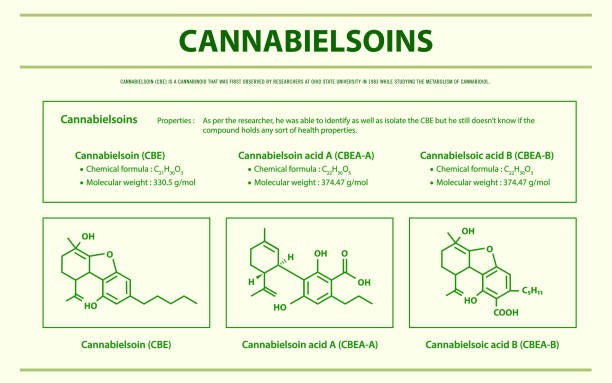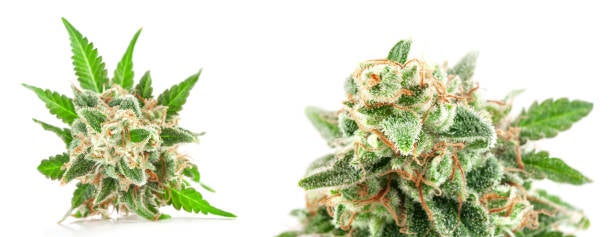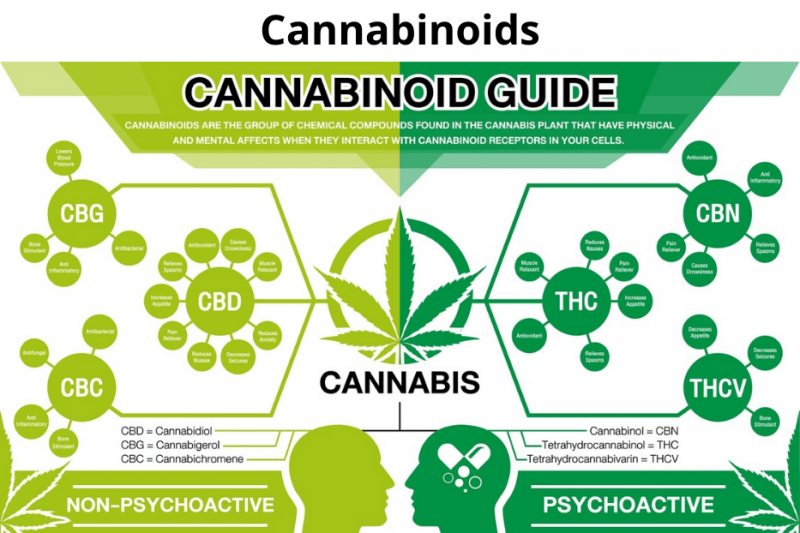It’s starting to seem like you can add any letter to the end of “CB” and come up with a cannabinoid. No, CBE isn’t the result of some offbeat stoner word game—it’s a real substance that might be available on the internet in the near future. What, exactly, is the cannabinoid CBE? You’ll find out in this guide.
What is the cannabinoid CBE?
(CBE) is a metabolite of CBD, which means it forms in the human body after CBD is ingested. Natural liver enzymes cause CBD to transform into CBE, and these enzymes can also be isolated and applied to CBD outside of the human body.
That’s how CBE is currently made for research and development purposes. Since both CBD and liver enzymes are natural substances, it’s not quite clear whether CBE should be considered a natural or synthetic cannabinoid. When CBE forms inside the body, it’s definitely a natural substance, but since CBE can only be created outside the body by combining chemicals, products made with converted CBE might be considered synthetic.
What are the effects of CBE?
Scientists don’t know much about the effects of CBE aside from the fact that it’s non-intoxicating. In general, it’s believed that metabolites of CBD are incapable of having intoxicating effects, and this position is backed up by the limited degree of research that has been conducted into CBE so far. So, while CBE is very unlikely to get you high, we don’t know enough about this cannabinoid to say exactly how it will affect you.
What are the benefits of CBE?
Not enough research has been conducted into CBE to be certain if this cannabinoid offers any benefits above and beyond those of CBD. All of the research performed on CBE to date has centered around this CBD metabolite’s chemical structure and methods of synthesis.
As CBD continues to gain popularity around the globe, it’s possible that we’ll learn more about CBE as well. Quite a few other cannabinoids are ahead of CBE in line, however, when it comes to generating widespread public attention.
How does CBE work in the body?
We don’t know a lot about how CBE works in the human body, but this cannabinoid is certainly interesting given its relation to CBD. Scientists have long known that CBD is metabolized by the liver, which is one of the main reasons that orally ingesting CBD is less effective than inhaling it. If it turns out that CBE is less potent in the body than CBD, that would help explain the liver’s CBD-suppressing effects.
Are there studies on CBE?
Yes, sporadic research has been conducted on CBE since this cannabinoid’s discovery in 1973. There are so many other cannabinoids to study, however, and for all intents and purposes, CBE simply seems to just be a watered-down form of CBD. As a result, hard data on CBE remain elusive, and it’s possible decades will pass before we have a clear idea of exactly what CBE is and what it does.
Why would people use CBE?
Without knowing anything about the effects or benefits of CBE, it’s hard to tell what the target market for this cannabinoid might be. There will always be CBD consumers, however, who are on the hunt for something new to try, so theoretically, CBE products might appeal to the more adventurous segment of the CBD-user population.
Does CBE have any side effects?
No studies have been conducted specifically into the side effects of CBE, but we can hazard some guesses based on what we know about CBD. Since CBE is a metabolite of CBD and CBD doesn’t appear to have any serious side effects, it’s likely the same is true for CBE. As the “processed” form of CBD, it’s even likely that any negative effects of CBE would be lesser than those of CBD.
Is CBE legal?

As a hemp cannabinoid that isn’t delta 9 THC, CBE is generally considered to be industrial hemp as long as it contains less than 0.3% THC. The legality of CBE is something of a moot point, however, since there aren’t even any consumer-grade CBE products on the market yet.
What is the difference between CBE and CBD?
CBE is a metabolite of CBD, so these cannabinoids are more similar than they are different. CBD and CBE have distinct chemical structures, however, and CBE can’t naturally occur in cannabis or hemp flower. It must first be exposed to liver enzymes, which can only be found naturally in mammalian bodies. So, in a way, CBE could be considered a cannabinoid-human hybrid while CBD is a “pure cannabinoid.”
What is the difference between CBE and delta 8?
In most cases, CBE and delta 8 share a synthesized past. Delta 8 THC can naturally occur in cannabis, however, and it usually does—albeit at concentrations significantly below 1%. CBE, on the other hand, is incapable of being naturally produced in cannabis.
What is the difference between CBE and CBL?
CBE and cannabicyclol (CBL) are similar in that they both appear when cannabinoids metabolize. CBL appears when cannabichromene (CBC) oxidizes, however, a natural form of metabolism that doesn’t involve liver enzymes. CBE, on the other hand, can only come into existence when CBD is exposed to substances found solely in mammalian bodies.
What is the difference between CBE and CBT?
Cannabicitran (CBT) is a naturally occurring cannabinoid like CBD—plain and simple. It’s not a metabolite of anything, and it doesn’t appear when other cannabinoids transform. CBT simply emerges during the natural maturation process of cannabis flower, so it bears little similarity to the liver metabolite CBE.
What is the difference between CBE and HHC?
Famous as one of the first synthetic cannabinoids, hexahydrocannabinol (HHC) is unlike CBE since it does not emerge as a metabolite of another cannabinoid. It’s possible that HHC naturally occurs in cannabis, but this theory is unproven. CBE and HHC are also different since HHC products are now widely available on the internet while it remains impossible to buy CBE.
What is the difference between CBE and CBF?
CBE and cannabifuran (CBF) are similar in their rarity and obscurity compared to other cannabinoids. Out of the two, we know even less about CBF than we do about CBE. While we know CBE is the result of CBE combining with liver enzymes, scientists still aren’t sure how CBF emerges from THC.
CBE cannabinoid FAQ
Let’s finish up with some commonly asked questions surrounding the subject of CBE and other rare cannabinoids:
1. How many cannabinoids are there?
Scientists have discovered more than 100 different cannabinoids in Cannabis sativa. Keep in mind, though, that each of these cannabinoids may have multiple metabolites or other forms, and it’s also possible we haven’t discovered all the cannabinoids there are to find in cannabis.
As a result, it’s possible there are already over a thousand substances identifiable as “cannabinoids,” and this list will only continue to grow over the years. If this number seems overwhelming, remember that only around a dozen cannabinoids appear to have benefits unique enough to merit their individual use.
2. Which hemp substances are considered “new cannabinoids?”
Since the vast majority of even rare cannabinoids were discovered decades ago, the term “new cannabinoid” can be somewhat deceptive. THCO and HHC are often referred to as “new” forms of THC, for instance, when the scientific community has been aware of these substances for more than 50 years.
In the end, a cannabinoid is “new” when the majority of cannabinoid consumers haven’t heard of it yet. As a result, almost all of the unique substances found in cannabis could be considered “new cannabinoids.”
3. Are cannabinoids drugs?
Cannabinoids are not generally classified as drugs. The only exceptions are THC, which remains a Schedule I illicit drug on the federal level, and Epidiolex, a CBD-based prescription drug approved by the FDA for certain forms of epilepsy and related conditions. Other cannabinoids are generally considered “industrial hemp,” a relatively unregulated legal category that does not contain any substances considered “drugs.”
4. Is CBs a cannabinoid?
No, there is no cannabinoid that’s abbreviated “CBS.” Perhaps just to be confusing, though, some writers contract the word “cannabinoids” down to “CBs,” a practice that unsurprisingly leads some cannabinoid enthusiasts to believe a new hemp substance has been discovered. There’s really no reason to abbreviate a word as simple as “cannabinoid,” so let’s just stick to the full word for the purposes of clarity.
5. Where can I learn more about cannabielsoin’s effects?
Right now, there’s simply now easy way to learn more about CBE and what it does. You can purchase isolated forms of this cannabinoid in bulk for research purposes, but doing so is extremely expensive, and research-grade cannabinoids are not intended for human consumption.
Combined with the fact that there is no research regarding the effects or benefits of CBE, we’ll need to simply content ourselves with being in the dark for the time being. It’s possible CBE will become more popular over time, spurring further research, but don’t expect any major movements on this front anytime in the near future.






















